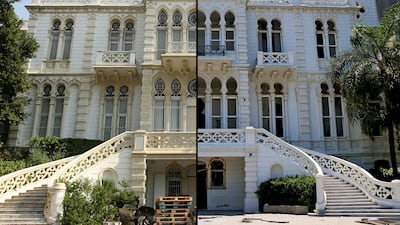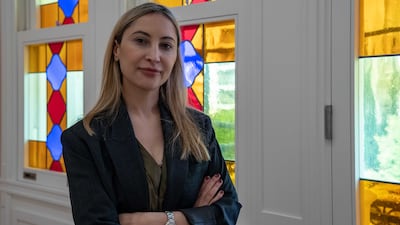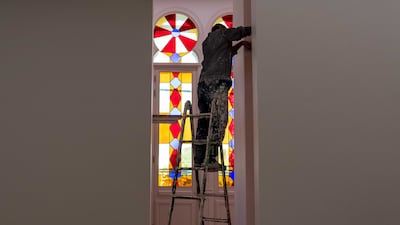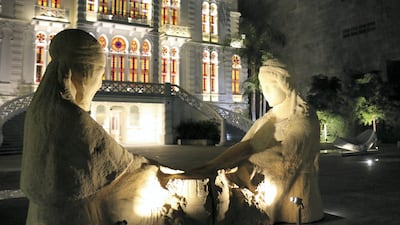Inside the Nicolas Ibrahim Sursock Museum, dozens of construction workers bustled around, painting and plastering the walls and completing the final touches to rehabilitate the historic Beirut villa devastated by the deadly port explosion two years ago.
The Sursock Museum, Beirut’s largest and oldest independent cultural institution, was the result of the will of Nicolas Sursock, a Lebanese collector and a member of one of Beirut’s most prominent families, to promote art in his country.
Over the past few years, the museum has played a prominent role in the art community in Lebanon by hosting exhibitions of local and international artists, and organising regular talks, screenings and workshops.
For the city of Beirut, the long-awaited reopening of the 20th-century building on Friday is a symbol of rebirth, two and a half years after a deadly explosion at the Beirut port destroyed large areas of the capital and killed more than 200 people.
The museum was heavily damaged in the blast and had to close its doors for nearly two years, but the cherished cultural institution has almost completely recovered from its wounds and will be ready to welcome visitors on Friday.
“It has been a collective healing process to see the museum rising from its ashes,” said Karina El Helou, the museum's director.
No media has toured the premises for months as the museum carried out extensive renovation work in the last phase of its rehabilitation.
The Salon Arabe on the historic first floor, renowned for its hand-carved woodwork imported from Damascus, has now been restored, while the facade's colourful stained glass, shattered by the explosion, has been recreated with the exact design.
The museum is now ready to hang artworks on the freshly painted walls of the exhibition spaces, while all 50 of the art pieces damaged during the explosion have been restored.
Sursock is Beirut’s largest art museum with a collection of 1,500 works that include masterpieces by prominent Lebanese artists such as Shafic Abboud, Paul Guiragossian and Jean Khalife.
“I feel it is a privilege to be here during this moment of revival,” Ms El Helou said as she walked up the stairs of the centuries-old villa surrounded by labourers busy at work.




Thanks to an outpouring of solidarity after the blast, the museum raised more than $2 million to fund restoration works, without any help from Lebanon’s bankrupt government.
The funds came mainly from the Italian government, which donated $965,000 under Unesco's Li Beirut initiative. The French Ministry of Culture and the International Alliance for the Protection of Heritage in Conflict Areas, a global fund dedicated to the rehabilitation of cultural heritage in conflict zones, each donated $500,000.
Upon his death in 1952, Sursock donated his mansion to the city of Beirut, saying at the time that he wanted his country “to receive a substantial contribution of fine artworks”.
The museum holds more than 12,000 archives on the art history in Lebanon and the region.
Rebirth in a time of collapse
Challenges remain for the newly appointed director, Ms El Helou, who took the position several months ago.
With Lebanon in the throes of a deepening economic crisis that has plunged 80 per cent of the population into poverty since 2019, the museum was forced to rethink its financial model.
“Before the crisis, the museum's activities were mostly financed by a tax on building permits levied by the Beirut Municipality,” Ms El Helou said.
But the municipality’s contribution in Lebanese pounds has become almost worthless, as the local currency crash lost more than 97 per cent of its market value against the dollar
“It now covers less than 2 per cent of our expenses,” Ms El Helou said.

The museum has had to deal, like all Lebanon businesses, with skyrocketing expenses, as it relies on costly private generators in the near absence of state electricity.
“This is our new challenge: creating a new fund-raising strategy to survive amid complete collapse,” Ms El Helou added.
Despite these financial challenges, charging visitors is out of the question. “Offering free access to art was in the will of Nicolas Ibrahim Sursock and we will always respect this,” she said.
A tribute to resilience
Despite the mounting difficulties, Ms El Helou is hopeful. “The museum has always shown resilience throughout the years,” she said.
From the very beginning, facing and overcoming challenges has been an integral part of the museum’s history.
It took nine years for Sursock’s will to be implemented, as former Lebanese president Camille Chamoun decided to turn the villa into a palais d’hotes — for welcoming visiting heads of states — instead of a museum.
The museum remained open during most of the 1975 to 1990 civil war, despite gun battles between rival militias, foreign invasions, and political turmoil.
In 2008, it closed for major renovation works, and reopened in 2015, before closing again after the Beirut blast.
“The museum’s history is deeply intertwined with that of Beirut, this makes it a depository of a Lebanese culture,” Ms Helou said.
The museum's new programming will be a tribute to its rebirth and resilience.
The exhibition space on the first floor will be dedicated to the history of the museum and its artists, including archives, pictures and press cuttings.
The second floor will, for a year, host an exhibition dedicated to some of the Sursock Museum's permanent collection around the history of the Salon d’automne, an annual exhibition for new artists to display their work and win awards.
“Looking back at our history is a way to pay tribute to those who helped by celebrating our institution,” Ms Helou said.
Scars from the Beirut blast are, however, still visible on the wooden entrance of the Salon Arabe, deliberately preserved as a reminder of the tragedy, widely blamed on endemic state corruption and negligence and for which no one has yet been held accountable.
“Reopening the museum does not mean we can forget what happened,” Ms El Helou said.
*This article story was originally published on February 3

